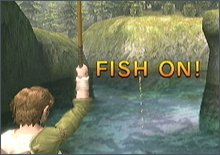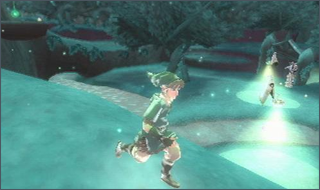The History of Pacing in the Zelda Series
Posted on October 28 2011 by Hanyou
 The Zelda series has undergone numerous changes throughout its history. As it has advanced, it’s naturally undergone a “streamlining” process, making it more accessible to new players. While this in itself is not bad, it has led to some trends that, when misused, have had detrimental results. The series started out with perfect pacing. In the original Legend of Zelda, the speed of the game was largely determined by the player. It wouldn’t stop for cutscenes, so gameplay was a constant; furthermore, advancement was limited by factors wholly within the player’s control.
The Zelda series has undergone numerous changes throughout its history. As it has advanced, it’s naturally undergone a “streamlining” process, making it more accessible to new players. While this in itself is not bad, it has led to some trends that, when misused, have had detrimental results. The series started out with perfect pacing. In the original Legend of Zelda, the speed of the game was largely determined by the player. It wouldn’t stop for cutscenes, so gameplay was a constant; furthermore, advancement was limited by factors wholly within the player’s control.
As the series moved forward, it naturally became more linear and more story-driven. This was a consequence of technology and a tighter focus on narrative, and there was absolutely nothing wrong with it.
The very beginning of A Link to the Past is a prime example. Freedom is limited, and Link is escorted through a series of scripted scenes–complete with their own special effects–to familiarize the player with the world. It’s a tutorial but also a crash course, as the first dungeon is hardly a pushover. Link’s Awakening would continue in a similar spirit; at the very beginning, Link didn’t even have a sword, which severely limited the navigability of the world. Forcing the player to find it was a logical and straightforward way to introduce the game world to the gamer.
Ocarina of Time was similar in its execution, with an ambitious, hour-long tutorial. Not only did Link lack a sword and shield, but characters stopped him at every turn to explain basic functions of the complex Nintendo 64 controller. Even the first dungeon was packed with Navi’s advice. Majora’s Mask was an extension of this same concept; while its first 45 minutes were different from any Zelda game that came before, they properly set up the game’s unique mechanics, atmosphere, and story.
Few would argue that these tutorials were detrimental to their respective games. One reason is that they’re packed with compelling gameplay and–with the exception of Majora’s Mask–are easy to power through. Both of these elements are important. A Link to the Past and Ocarina of Time open with dungeons; Ocarina might require a bit of exploration at the very beginning, but you’re in the Deku Tree within minutes of starting the game. Majora’s Mask is so intense at the start that the player probably isn’t too worried about how limiting it is. Link’s Awakening confines the player for about five minutes at most, familiarizing him or her with a part of Koholint Island that will be significant throughout the game.
None of this can be said for most of what followed. Except for the Capcom-developed Zelda games, which generally follow Nintendo’s classic philosophy of a brief tutorial and then an open game environment, most recent Zelda games feel like tutorials for significant portions of the game.
The Wind Waker was the first time this really became noticable. While the game as a whole was a masterpiece, a worthy successor to the highly-acclaimed Ocarina of Time and Majora’s Mask, it bore an important weakness: for a good while, it felt limiting. Outset Island echoes Kokiri Forest, though it seems to feature more exposition and fewer player-controlled circumstances. In a word, it’s slower. To get your shield, you have to exert less effort, but you have to sit through more dialog. There’s a good deal of ceremony when Link leaves outset, and perhaps fewer silent moments. The game is, by design, less reserved in telling the gamer how to feel or what to think. While this isn’t initially jarring, it has an effect on gameplay; player involvement has perhaps a bit less of a role than it did in previous Zelda games.
 This isn’t much of an issue until it becomes a continuous theme in the game. From Outset, you’re whisked away to the Forsaken Fortress and forced to undergo a specific regimen that barely changes on subsequent playthroughs. If you don’t like the Forsaken Fortress, too bad; you have to play all the way through it and hope you enjoy the next part of the game more. Especially with its focus on stealth, an element that’s never been played up that much in past entries, this segment was naturally divisive; some gamers may have enjoyed it, but some may not have, and there was nothing they could do about it but endure it. And it isn’t entirely over when you get to Windfall Island, either. In principle, it’s not so different from any other introduction in a Zelda game; in execution, it lasting a couple hours into the game has the potential to be extremely tedious. It’s a simple consequence of design, since the boat cannot operate without the sail, but it takes so long to acquire basic mobility–the sail, then the Wind Waker after the first dungeon–that the game hardly seems free-roaming. Fortunately, The Wind Waker arguably redeems itself, as the majority of the game leaves the player free to explore an open, rich world full of mystery. The player determines the pace of the rest of the game, linear and story-heavy though it may be. This reduces the potential for tedium, though gamers who leave the entire Triforce quest for last may take issue with the exploration element as well.
This isn’t much of an issue until it becomes a continuous theme in the game. From Outset, you’re whisked away to the Forsaken Fortress and forced to undergo a specific regimen that barely changes on subsequent playthroughs. If you don’t like the Forsaken Fortress, too bad; you have to play all the way through it and hope you enjoy the next part of the game more. Especially with its focus on stealth, an element that’s never been played up that much in past entries, this segment was naturally divisive; some gamers may have enjoyed it, but some may not have, and there was nothing they could do about it but endure it. And it isn’t entirely over when you get to Windfall Island, either. In principle, it’s not so different from any other introduction in a Zelda game; in execution, it lasting a couple hours into the game has the potential to be extremely tedious. It’s a simple consequence of design, since the boat cannot operate without the sail, but it takes so long to acquire basic mobility–the sail, then the Wind Waker after the first dungeon–that the game hardly seems free-roaming. Fortunately, The Wind Waker arguably redeems itself, as the majority of the game leaves the player free to explore an open, rich world full of mystery. The player determines the pace of the rest of the game, linear and story-heavy though it may be. This reduces the potential for tedium, though gamers who leave the entire Triforce quest for last may take issue with the exploration element as well.
The problem was compounded by the linearity in Twilight Princess. Many people made the mistake of just criticizing Twilight Princess’ linearity–but of course, most Zelda games are linear, or at least have a “preferred” order for the dungeons. The issue with Twilight Princess is that it is filled with “tutorial”-type gameplay for an even longer amount of time than The Wind Waker. The first three dungeons are preceded by lengthy Tears of Light segments which are nothing more than glorified fetch quests broken up by tedious exposition, much of which is redundant characterization for characters we’ll scarcely see or care about afterward. Subsequently, every dungeon must be traversed in order, also preceded by lengthy segments of exposition.
Opinions naturally differ on Twilight Princess as a whole. It was very well-received. In my experience, it moved at a snail’s pace. It took far too long to reach any dungeon, and the process of getting to a dungeon was not strictly about gameplay. Often, it was about, well, busywork that didn’t serve to properly advance the plot or familiarize the player with the gameplay. It was also confining because advancement was extremely limited. If you didn’t like the Tears of Light segments, there wasn’t much else you could do except participate in them; other gameplay opportunities in the game were sparse, limited by the linear nature of the field.
Phantom Hourglass and Spirit Tracks experienced similar pacing issues on a smaller scale. Both were quite often linear. Both had “central” dungeons that were roundly criticized by fans and detractors of the games alike. Both were plot-heavy, arguably at the expense of gameplay. None were as glaringly limiting as Twilight Princess had been, but they carried on the tradition, and were worse than they could have been for it.
Everything we’ve been told about Skyward Sword points to it being an evolution of these recent trends. It features an open world in the clouds above, but a more strictly “designed” world below, with a tighter construction than we’re used to for an overworld. Dungeons and the overworld are streamlined. Plot plays a major role in the game’s execution. Perhaps most notable is the Silent Realm–with its limiting nature and focus on stealth gameplay, it’s reflective of recent trends. This is not inherently bad–it’s the sort of concept that could be well-executed. But if the development team has not streamlined it, has not offered the player a bit more freedom and has not sped up these segments, it could be obnoxious.
 Say what you will about modern Zelda games–they have their strong points and gamers the world over can likely find something to like in most of them. They are well-designed. But perhaps that is part of the problem; perhaps they are too well-designed. In the future, the franchise could benefit from a looser, less plot-focused construction. It’s tempting for developers to make games plot-heavy now that technology allows for more character expression, but when it comes at the expense of consistent gameplay with a good flow, it becomes a problem. There are a number of solutions to the problem of pacing, however pervasive Zelda fans think it is. One is to revert to classic gameplay styles and downplay the story element. Another–perhaps more daring–is to take what has been learned from past entries and continually improve on it. As Zelda games continually offer “tutorial” segments throughout, this is perhaps the best gamers can hope for.
Say what you will about modern Zelda games–they have their strong points and gamers the world over can likely find something to like in most of them. They are well-designed. But perhaps that is part of the problem; perhaps they are too well-designed. In the future, the franchise could benefit from a looser, less plot-focused construction. It’s tempting for developers to make games plot-heavy now that technology allows for more character expression, but when it comes at the expense of consistent gameplay with a good flow, it becomes a problem. There are a number of solutions to the problem of pacing, however pervasive Zelda fans think it is. One is to revert to classic gameplay styles and downplay the story element. Another–perhaps more daring–is to take what has been learned from past entries and continually improve on it. As Zelda games continually offer “tutorial” segments throughout, this is perhaps the best gamers can hope for.



